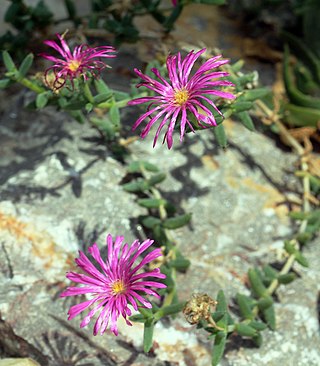
The Aizoaceae, or fig-marigold family, is a large family of dicotyledonous flowering plants containing 135 genera and about 1,800 species. Several genera are commonly known as 'ice plants' or 'carpet weeds'. The Aizoaceae are also referred to as vygies in South Africa. Some of the unusual Southern African genera—such as Conophytum, Lithops, Titanopsis and Pleiospilos —resemble gemstones, rocks or pebbles, and are sometimes referred to as 'living stones' or 'mesembs'.

Lampranthus is a genus of succulent plants in the family Aizoaceae, indigenous to southern Africa.
Amphibolia obscura is a species of plant in the family Aizoaceae. It is endemic to Namibia. Its natural habitat is rocky areas. It is threatened by habitat loss.
Antimima argentea is a species of plant in the family Aizoaceae. It is endemic to Namibia. Its natural habitat is subtropical or tropical dry shrubland.

Antimima is a succulent plant genus in the family Aizoaceae, indigenous to South Africa and Namibia.
Antimima buchubergensis is a species of plant in the family Aizoaceae. It is endemic to Namibia. Its natural habitats are subtropical or tropical dry shrubland and rocky areas.
Antimima eendornensis is a species of plant in the family Aizoaceae. It is endemic to Namibia. Its natural habitats are subtropical or tropical dry shrubland and rocky areas. It is threatened by habitat loss.
Antimima modesta is a species of plant in the family Aizoaceae. It is endemic to Namibia. Its natural habitats are subtropical or tropical dry shrubland and rocky areas.
Antimima quartzitica is a species of plant in the family Aizoaceae. It is endemic to Namibia. Its natural habitat is rocky areas. It is threatened by habitat loss.
Psammophora saxicola is a species of plant in the family Aizoaceae. It is endemic to Namibia. It is threatened by habitat loss.

Trianthema is a genus of flowering plants in the ice plant family, Aizoaceae. Members of the genus are annuals or perennials generally characterized by fleshy, opposite, unequal, smooth-margined leaves, a prostrate growth form, flowers with five perianth segments subtended by a pair of bracts, and a fruit with a winged lid. The genus contains about 30 described species growing in tropical and subtropical regions, especially Australia. One common species, Trianthema portulacastrum, desert horse purslane, is frequent as a weed in agricultural areas and is widely distributed.

Drosanthemum ("dewflowers") is a genus of succulent plants in the ice plant family native to the winter-rainfall regions of southern Africa, including Namibia and the Cape Provinces and Free State of South Africa. Most species bear colorful flowers.

Jordaaniella is a genus of plants in the family Aizoaceae. The plants of this genus are indigenous to Namibia and South Africa's Cape Provinces in southern Africa. Seven species are accepted:

Acrodon is a genus of ice plants from South Africa. It comprises five species, mostly endangered and all restricted to the southern Cape regions of the Western Cape and Eastern Cape Provinces, South Africa.

Trichodiadema mirabile is succulent plant of the genus Trichodiadema, native to the Western Cape Province, South Africa, where it is known from the Laingsburg area and especially from south-facing slopes.

Trichodiadema barbatum is succulent plant of the genus Trichodiadema, native to the Eastern Cape Province, South Africa.
Brianhuntleya is a genus of flowering plants belonging to the family Aizoaceae.
Eberlanzia is a genus of flowering plants belonging to the family Aizoaceae.

Trichodiadema setuliferum is a succulent plant of the genus Trichodiadema, native to the Karoo regions of the Cape Provinces, South Africa.










